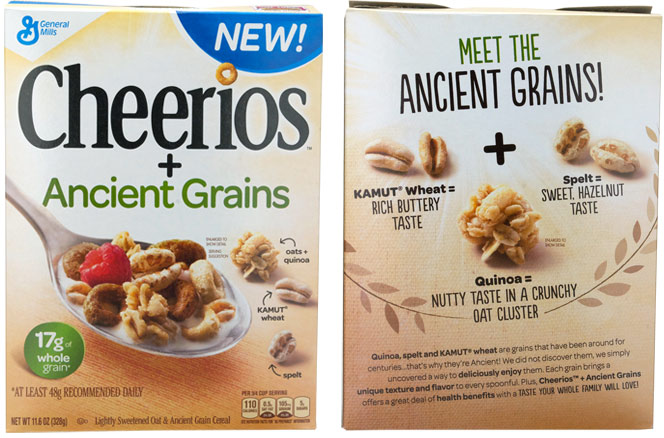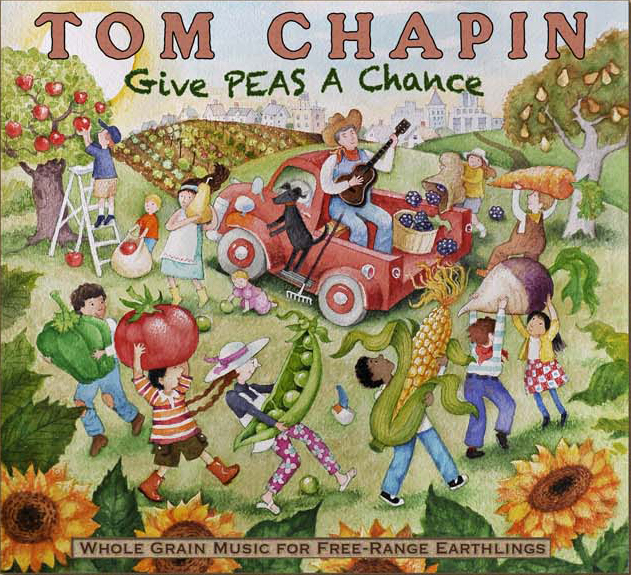Does General Mills get ideas from The Onion? Or vice versa?
From The Onion: “New Omnigrain Cheerios Made With Every Existing Grain On Earth”

From Wegmans, Ithaca:

Truth is stranger than satire.

From The Onion: “New Omnigrain Cheerios Made With Every Existing Grain On Earth”

From Wegmans, Ithaca:

Truth is stranger than satire.
Thanks to Melanie Nesheim for sending me a link to Russ Greene’s (The Russells) account of Nick Jonas’s dispute with Crossfit over its posting of this image.
As best as I can tell, here’s what happened.
Nick Jonas of the Jonas Brothers, who has Type 1 diabetes, sent out a tweet objecting to this image as insulting to people with type 1 diabetes. Note: Sugary beverages are a not a risk factor for type 1 diabetes but they are for type 2 (see, for example this, this, and this).
Russ Greene entered the fray with a tweet pointing out that Coca-Cola sponsors the Jonas Brothers’ concerts.
Apparently, this caught the attention of Good Morning America.
A spokesman for Nick Jonas denied that he had any kind of deal with Coca-Cola.
Maybe not, but as Mr. Greene pointed out, Coca-Cola presents or sponsors the concerts and advertises that it does so.
My conclusions from this incident:
And, of course, I examine this sort of sponsorship in much greater detail in my forthcoming Soda Politics: Taking on Big Soda (and Winning), which comes out in October.
Helena Bottemiller Evich of Politico Morning Agriculture, has produced an alarming investigation of the Obama Administration’s failure to support its own food safety initiatives. Fortunately, Politico has released it from behind the paywall so it can be read by non-subscribers. Do read it. It’s a depressing slice of political reality.
The Obama administration and Congress have all but squandered an opportunity to give the anemic Food and Drug Administration, which is responsible for the safety of 80 percent of the nation’s food supply, a level of oversight the public long assumed it already had.
On paper…the Food Safety Modernization Act…mandated more inspections and much tougher anti-contamination standards for everything from peaches to imported pesto sauce, and it placed more emphasis on preventing outbreaks than on chasing them down after people become sick.
But almost five years later, not one of the sweeping new rules has been implemented and funding is more than $276 million behind where it needs to be. A law that could have been legacy-defining for President Barack Obama instead represents a startling example of a broad and bipartisan policy initiative stymied by politics and the neglect of some of its strongest proponents.
The result is shown in this chart.
 She adds:
She adds:
The White House has routinely put nutrition policy ahead of food safety, sat on key regulations for months and made only halfhearted attempts to fund the law…Congress, too, bears blame: With no real pressure from the White House or the public, Capitol Hill has given the FDA less than half of what the agency says it needs to actually enforce the new rules, once they take effect.
I’m not so sure about the “putting nutrition ahead” part of this. Critics have long complained that the White House could have done much more to promote healthier diets. They recall the lack of support for the Interagency Working Group’s recommendations for nutrition standards for marketing to children. Menu labeling has just been delayed a year (although advocates tell me that this compromise was necessary to keep labeling for pizza places and movie theaters—ultimately a victory).
This administration has about a year left to get its legacy in order. A full-court press in support of the FDA is just what is needed. Now!
My dear friend, the food writer, cookbook author, and restaurant consultant Joyce Goldstein, is also a careful analyst of today’s global political scene.
She points out that the New York Times account (exceptionally clear, by the way) of the ongoing nuclear talks with Iran suggests one reason why they are going on endlessly:
To sustain itself during its marathon meetings, the United States negotiating team has since the beginning of June consumed at least 10 pounds of Twizzlers, 30 pounds of mixed nuts and dried fruit, 20 pounds of string cheese and more than 200 Rice Krispie Treats, according to its informal count.
Fruits and vegetables anyone?
Let’s join in a chorus of “Give Peas a Chance.”

Yesterday, the FDA announced a delay in implementation of menu labeling until December 1, 2016.
Since the FDA issued the menu labeling final rule on December 1, 2014, the agency has had extensive dialogue with chain restaurants, covered grocery stores and other covered businesses, and answered numerous questions on how the rule can be implemented in specific situations. Industry, trade and other associations, including the grocery industry, have asked for an additional year to comply with the menu labeling final rule, beyond the original December 2015 compliance date. The FDA agrees additional time is necessary for the agency to provide further clarifying guidance to help facilitate efficient compliance across all covered businesses and for covered establishments to come into compliance with the final rule. The FDA is extending the compliance date for the menu labeling rule to December 1, 2016, for those covered by the rule.
Here are the relevant Federal Register notices:
Let’s be clear about what’s going on here. New York City, where I live, has had menu labeling since 2008. The world has not come to an end.
The Affordable Care Act made menu labeling go national in 2010. The Supreme Court affirmed that law in 2012.
The seemingly endless delays look like successful lobbying at the expense of consumers and public health.
The New York Times account quotes me on this point:
This is a huge victory for the restaurant lobbyists,” said Marion Nestle, a professor in the department of nutrition, food studies and public health at New York University. “Food companies must be hoping that if they can delay menu labeling long enough, it will just go away.
The pizza industry, one of the chief lobbying groups on this issue, is pleased by the decision. Lynn Liddle, Chair of the American Pizza Community sent out this statement yesterday:
FDA’s delay confirms both the serious deficiencies in the final rules and the urgent need for enactment of the bipartisan Common Sense Nutrition Disclosure Act (H.R. 2017). Unfortunately, FDA proceeded with an approach to final rules that impose significant compliance costs without achieving any meaningful improvements in consumer education. After years of uncertainty, FDA still has not addressed basic questions regarding implementation. The American Pizza Community looks forward to continuing to work with Members of Congress to secure timely passage of the Common Sense Nutrition Disclosure Act.
If you can’t get federal agencies to back off on public health, go right to Congress.
The pizza industry had already succeeded in getting this provision in the House Agricultural Appropriations bill:
SEC. 744. None of the funds made available by this Act may be used to implement, administer, or enforce the final rule entitled ‘‘Food Labeling; Nutrition Labeling of Standard Menu Items in Restaurants and Similar Retail Food Establishments’’ published by the Food and Drug Administration in the Federal Register on December 1, 24 2014 (79 Fed. Reg. 71156 et seq.) until the later of— (1) December 1, 2016; or (2) the date that is one year after the date on which the Secretary of Health and Human Services publishes Level 1 guidance with respect to nutrition labeling of standard menu items in restaurants and similar retail food establishments.
Although this act is not yet passed and it’s not clear whether this provision would have survived, the FDA got the message (or maybe the White House made sure that it did?).
Menu labels inform the public about the number of calories in the foods they are buying.
The ferocity of lobbying on this idea suggests that restaurant companies would rather you did not have this information.
The FDA, alas, is not helping much on this one.
The nutrition transition is the term used to describe a population’s rapid shift from widespread undernutrition to even more widespread overnutrition and its health consequences.
Here is an example of how that happens.
Thanks to Catherine Normile, currently working in Myanmar, for this report.
The first KFC, and the first major American fast food chain for that matter, opened in Yangon yesterday. I didn’t go inside but I scoped it out, I thought you may be interested to see the incredible crowd outside, and how unfortunate a contribution this is to Yangon’s downtown. It’s on a main road directly across the street from Bogyoke Market, the busiest market in Yangon. My favorite quote comes from this Jakarta Post article: “It is internationally famous, so I think it must be healthy.” Said by a man who queued for 3 hours to get chicken.
Note the waiting crowd.

There were long lines to get in.

The Burmese diet is changing. Catherine’s previous report was on the influx of Coca-Cola.
I’ll ask again: is anyone tracking changes in health statistics in that country?
Sadie Barr, who writes about school food problems in Washington, DC, wants me and readers to know about the recent $19.4 million settlement paid to the DC school district by its food service provider, Chartwells.
For what? Overcharging the schools for its meals.
In an e-mail to me, she writes:
The issue of school food fraud isn’t new, and isn’t unique to DC. It happened in New York in 2010 and in 2012, and is probably occurring within the quarter of school districts nationwide that outsource their food service. It was written about in the New York Times in 2011 and in an investigative report published in 2009. This fraud represents millions (if not billions) of public funds going toward a company’s profits, instead of education.
How does this work? Food service companies buy foods from manufacturers who give them kickbacks, but do not pass the savings along to the schools.
She points out that this scam affects quality of school food, posing a special burden to the more than 50% of students nationwide (it’s more than 70% in DC) who qualify for free and reduced priced meals.
The lawyers negotiating the settlement were from Phillips & Cohen LLP, a firm that specializes in representing whistleblowers. In this case, the whistleblower was Jeffrey Mills, director of food services for the DC public schools from 2010 to 2013.
The Phillips & Cohen press release quotes Mills as complaining that Chartwells overcharged the school district and also caused circumstances when “food was delivered late, the number of meals was insufficient or the food was of poor quality or spoiled.”
Mills said that his goal had always been to improve food programs for DC’s school children: “District funds should be used to feed students the best quality food at the lowest cost.”
This is not the first time Chartwells got caught doing something like this.
In 2012, Chartwells’ parent company, Compass Group USA, paid $18 million to settle allegations by the New York Office of the Attorney General that the company wrongfully retained rebates on purchases of food and non-food commodities made under contracts with 39 school districts in that state.
Phillips & Cohen also say:
The allegations made in the District’s complaint and Mr. Mills’ complaints are allegations only. The allegations against Chartwells have not been adjudicated. Chartwells denies liability for the allegations.
Maybe so, but the company agreed to the $19.4 million of the DC case.
If you are having trouble understanding the fights over the USDA’s school nutrition standards, the Chartwells’ case should help.
For food service companies and the companies that supply food products, there is lots of money to be made on school meals.
Addition, July 9: DC, it seems, is renewing its contract with Chartwells, according to the Washington City paper’s story on Jeff Mills.
Addition, July 10: The Washington City paper explains the politics of Chartwells in DC.
When I was in Cuba in 1992, the only food available to tourists was at the hotels: no restaurants, no street carts, no corner groceries, no family garden plots, no urban agriculture (for FAO information on Cuban food security, see this link).
On this Food First sovereignty trip, the big surprise was that restaurants were everywhere. An outdoor restaurant in Old Havana’s cathedral square!

Plenty of restaurants serve terrific food.

Some chefs, like Alejandro Robaina, at La Casa Restaurante (on the left), seem poised for a wildly successful TV career.

Cuban food invariably comes accompanied by lively music.

We saw farmers’ markets throughout Havana.

These are explained as part of the revolution.

We saw specialty food shops in Old Havana.

Street sellers peddle food from carts.

But Cuba doesn’t have much in the way of food manufacturing. Small bodegas and even the large suburban Supermercado do not sell many products. What they do have is mostly imported. I saw some Cuban mayonnaise but couldn’t find Cuban coffee anywhere except at the airport.
Even this Supermercado sells only one kind of item. The oil is soy, bottled in Cuba from U.S. soybeans.

Many of the shelves are empty because of the U.S. embargo and for general lack of money.
A couple of anecdotes about how the Cuban economy is changing:
The revolution made everyone equally poor, although with excellent free education, health care, and a basic food ration (the libreta) that kept everyone from total starvation, even during the worst of the 1990s. This created a relatively classless society.
First change: Remittances. Many families who left Cuba to get away from the Castro regime did well and sent money (“remittances”) to their relatives back home. We were told that these amounted to $2 billion last year in total and that the money is transmitted via Western Union and couriers (“mules”).
The average Cuban salary and pension is $20 per month. A remittance of $100 a month makes that person rich.
Second change: Deregulation of real estate. One of our speakers told us that when private ownership of housing was first permitted a decade ago, he bought a house for the equivalent of $650. As soon as the rules changed and allowed market rates, he sold it last year for $150,000.
Cuba’s contradictions are interesting to observe. Go see them while you can.